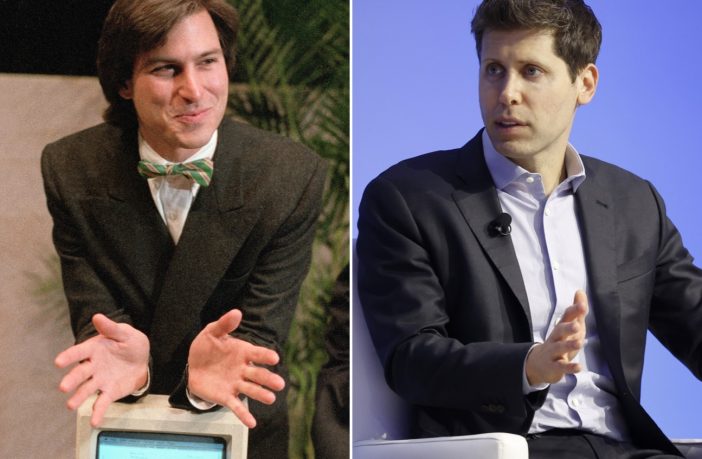
Jobs’ divorce from Apple mirrors, in many ways, the OpenAI saga that culminated in the ouster of CEO Sam Altman, rumors of his return, threats of mass staff departures, and his eventual hiring by Microsoft – which, along with founder Bill Gates, was also a main rival of Jobs and Apple several decades ago.
Jobs founded Apple when he was a 21-year-old college dropout in 1976 with his friend Steve Wozniak. In 1984, Apple featured the Macintosh in a Super Bowl commercial named by Advertising Age as the commercial of the decade. But Mac sales lagged, and Jobs, described by many at the time as “temperamental,” began clashing with John Sculley, a company executive. Jobs had brought in Pepsi a year earlier to help run the company.
For Jobs, Sculley was a mentor, the Washington Post reported at the time. The two were inseparable during Sculley’s first two years: Sculley ran the company’s operations while Jobs led the Macintosh team.
However, as revenue from the new computer fell short of expectations, pressure increased for Apple to stabilize its business. And Jobs was increasingly seen as a chaotic force incapable of controlling his character.
Sculley, the leader with a traditional business background, took control, proposing a “restructuring” that would strip Jobs of all power, combining his team with that of the personal computer-focused Apple II Group.
Furious, Jobs went to the board to make his case, according to the Corporate Governance Institute.
In May 1985, the board sided with Sculley. Jobs would remain president, losing his job leading the Macintosh team and his direct reports.
“This is an effort to increase efficiency,” Bill Campbell, the executive who oversaw Apple’s U.S. sales and marketing, told the Post at the time. He added that Jobs would act as a “resource” to the company.
The board concluded that the CEO had become an “impediment” to growth and “had been put out to pasture,” the Post wrote. Apple executives were increasingly frustrated by the co-founder’s “temperamental” behavior, the newspaper reported, adding that the financial community would be happy with the decision.
Wozniak, who left Apple in February of that year, told the New York Times that Jobs “could never see himself in second place at Apple.”
A few months later, Jobs had had enough. He sold $20 million worth of his stock and told Apple he would launch a new computer company.
In his resignation letter, he wrote that “the company seems to be adopting a hostile attitude towards me.”
In Jobs’ account, he told the board before his resignation that he would hire some of Apple’s managers. According to Apple, Jobs did not clearly express his intentions.
Sculley later wrote that he thought he gave Jobs too much power when Jobs led the Macintosh team.
“I had given Steve greater power than he had ever had and I had created a monster,” Sculley wrote in his book “Odyssey: Pepsi to Apple.”
Five senior executives would resign to join Jobs’ new company, Next, which Jobs said would build a powerful new computer for universities.
It sparked a bitter separation that seemed irreparable — and a lawsuit from Apple that would bar Jobs from competing with the company. Jobs remained Apple’s largest stakeholder, with $90 million in stock.
“I didn’t know Apple owned me,” Jobs said at the time. “It’s hard to think that a $2 billion company with over 4,300 employees can’t compete with six people in jeans.”
More than a decade later, Jobs would return to Apple and begin the path that would make the company the cultural and technological force it is today. But first, the multimillionaire threw himself into something else.
He purchased the Pixar film studio from Lucasfilm in 1986, supporting the company in its efforts to make what would become “Toy Story” in 1995, which was the world’s first fully computer-animated feature film, according to the Academy of Sciences. Motion Picture Arts and Sciences.
During the same decade, he built Next into a company that, despite mixed results, influenced the future of software (and the Internet; the World Wide Web was created on one of his computers). Then he created an operating system that attracted big-name clients and would help bring Jobs back to Apple.
Apple then needed Jobs. The situation was precarious, with declining market share and profits. In December 1996, Jobs and the company announced his return. In a merger that surprised the industry, Apple would acquire Next and its software for about $400 million, and Jobs would be tapped to help with a critical task: developing a new operating system for Macs. .
He was returning, The Post reported, “to help spark a turnaround at the now struggling company” after layoffs, management changes and a single-digit share of the home and desktop computer market. It took a decade before the first iPhone was released, and Apple’s success was far from inevitable.
In January 1997, Jobs kicked off his comeback by appearing on stage with Gilbert F. Amelio, then Apple’s CEO, at the MacWorld Expo. He was Amelio’s advisor and part-time consultant, but by July Amelio had resigned. Jobs have taken over.
In a speech at Stanford in 2005 and viewed 43 million times on YouTube, Jobs said his departure from Apple in 1985 was liberating.
“I didn’t see it at the time, but it turned out that getting fired from Apple was the best thing that could have happened to me,” he said. “The heaviness of succeeding has been replaced by the lightness of being a beginner again.”
Gn tech




